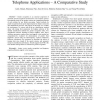Free Online Productivity Tools
i2Speak
i2Symbol
i2OCR
iTex2Img
iWeb2Print
iWeb2Shot
i2Type
iPdf2Split
iPdf2Merge
i2Bopomofo
i2Arabic
i2Style
i2Image
i2PDF
iLatex2Rtf
Sci2ools
CORR
2016
Springer
2016
Springer
Gender Identification using MFCC for Telephone Applications - A Comparative Study
— Gender recognition is an essential component of automatic speech recognition and interactive voice response systems. Determining gender of the speaker reduces the computational burden of such systems for any further processing. Typical methods for gender recognition from speech largely depend on features extraction and classification processes. The purpose of this study is to evaluate the performance of various state-of-the-art classification methods along with tuning their parameters for helping selection of the optimal classification methods for gender recognition tasks. Five classification schemes including k-nearest neighbor, naïve Bayes, multilayer perceptron, random forest, and support vector machine are comprehensively evaluated for determination of gender from telephonic speech using the Mel-frequency cepstral coefficients. Different experiments were performed to determine the effects of training data sizes, length of the speech streams, and parameter tuning on classificat...
| Added | 01 Apr 2016 |
| Updated | 01 Apr 2016 |
| Type | Journal |
| Year | 2016 |
| Where | CORR |
| Authors | Jamil Ahmad, Mustansar Fiaz, Soon-il Kwon, Maleerat Sodanil, Bay Vo, Sung Wook Baik |
Comments (0)

